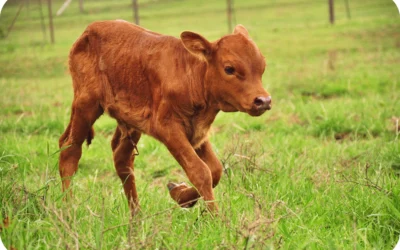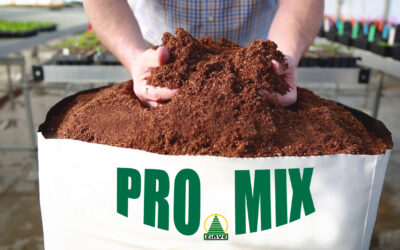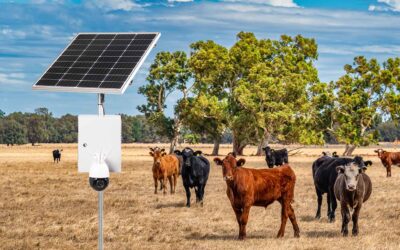The greatest risk occurs when the calf will receive too little colostrum,
which puts the calf at great risk of disease and death.
The traditional recommendation has been to feed 2 quarts of colostrum as soon as possible after birth and then again, 12 hours later. Is this recommendation still applicable today? Feeding too much colostrum is not usually considered a problem – unless it is fed at one time. So, how much is too much and how little is too little?
Unfortunately, the answer is not as easy as it seems. The amount of colostrum to feed really depends on several factors – including the amount of antibody (or Ig) in the colostrum, the body weight of the calf, the age of the calf at first feeding, and several other factors.
Generally, the amount of colostrum was assumed – usually we assumed that 2 quarts of colostrum in each of two feedings would do the trick. However, in many cases, this will not provide enough antibody to the calf.
The issue of how much colostrum to feed is extremely important – to the producer and to the newborn calf.
Using a colostrometer can provide you with an idea of whether the colostrum is of sufficient quality (see Calf Note, Using the colostrometer to measure colostrum quality) So what are you to do? Many veterinarians recommend feeding 4 quarts of colostrum to Holstein calves in the first feeding – by esophageal feeder if necessary. By feeding a large amount in the first feeding, you can maximize absorption of antibody.
Of course, Jersey calves and small Holsteins should be fed a smaller amount. Another approach is to look at the volume of colostrum produced. Washington state researchers reported that when a cow produces more than about 18 lbs. of colostrum, it may contain less Ig than necessary to provide adequate passive immunity for the calf.
Do
Don't
Allow cows to calve in a clean, dry maternity pen or on a clean pasture.
Separate calves from the dam as soon as possible.
Feed first feeding of colostrum as soon as possible (within 1 hour) Use fresh colostrum from the dam if good quality Feed at least 3 quarts of colostrum in the first feeding and again 12 hours later (If colostrum quality can be determined and is of good quality, feed 2 quarts at the first feeding).
Feed 3 quarts of colostrum at each feeding if the calf is 45 kgs, has not consumed colostrum within the first 6 hours, or if the calving environment is dirty Use an esophageal feeder if the calf will not consume sufficient colostrum.
Measure colostrum quality with a colostrometer before use
Use only good quality colostrum Save good quality colostrum by freezing in 1 or 2 quart bottles. Thaw colostrum carefully to preserve antibodies Use fair and poor quality colostrum and transition milk only for older calves.
Dip navels with tincture of iodine as soon as possible
Put calf in an isolated, dry, and draft-free environment Continue to feed lower quality colostrum or transition milk for 2 to 3 days after birth.
Don’t forget to separate close-up cows from the herd, or forget to clean pens between cows.
Don’t leave the calf and dam together for more than an hour.
Don’t use colostrum from cows that are leaking colostrum from their udder prior to or at calving.
Use colostrum that contains blood or is mastitic. Wait for the calf to get up on its own and nurse Allow the calf to get its colostrum from nursing the dam, or feed less than 2 quarts per feeding Use a broken or dirty esophageal feeder.
Don’t use thin, watery colostrum, especially if from a heifer Use colostrum that contains blood or is otherwise abnormal Place frozen colostrum in extremely hot water or thaw in a microwave under high power for 1 min at a time (this destroys antibodies) Feed poor quality colostrum at the first 2 feedings.
Don’t use teat dip or other solution other than tincture of iodine to dip navels. Group calves together or house calves in a wet or drafty environment.
Estimated colostrum required by a 40 kg calf to achieve minimum plasma IgG concentration of 10 g/L at 24 hours of age.
- Calf body weight 40 kg
- Plasma volume (9% of BW) 3.6 liters
- Minimum Plasma concentration 10 g/L
- Apparent efficiency of absorption 35 %
- Required IgG intake (3.6 × 10 / 0.35) 103
- grams Colostral concentration 50 g/L
- Required amount to feed 2.1
To calculate he amount (or mass) of IgG that a calf needs, several assumptions may be made, based on existing research data (Figure above).
Our goal is for the calf to obtain a minimum of 10 grams of IgG per liter of serum.
A calf’s plasma volume at 24 hours of age is approximately 9% of its body weight. To achieve 10 g/L, a newborn calf that weighs 40 kg (about 88 lbs.) must consume 36 grams of IgG from colostrum or a supplement by 24 hours of age. However, IgG is not absorbed with 100% efficiency. Research data suggest the efficiency is closer to 35% (the other 65-70% equilibrates with other body pools or is not absorbed at all).
So, to achieve 10 g/L, the calf must consume 103 grams of IgG (36 grams / 35%) by 24 hours. If a margin of safety is included in the calculations (achieving a plasma IgG concentration of 15 grams of IgG per liter), the calf needs to consume 154 grams of IgG. The efficiency of IgG absorption is an important component of the IgG intake equation. Efficiency is not a constant, but changes (declines) according to a number of factors – however, the most important is age at first feeding. Efficiency of IgG absorption is highest immediately after birth and declines to nearly zero by 24 hours of age.
Thereafter, little of the IgG consumed is absorbed into the bloodstream. Because efficiency of absorption declines with age, it’s critically important for colostrum (or supplements) to be fed as soon as possible after birth. Research estimates of efficiency of absorption vary widely and range from as high as 65% to as low as 25%.




